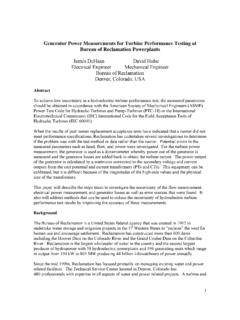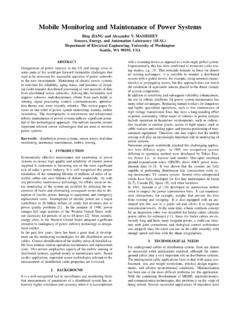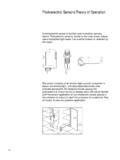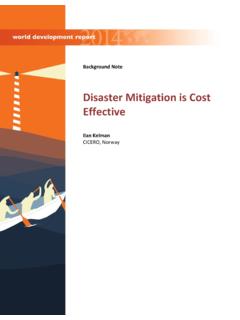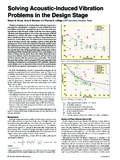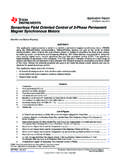Transcription of Background paper - Reducing losses in the power …
1 Reducing Technical and Non Technical losses in the power Sector Background paper for the World Bank Group Energy Sector Strategy July 2009 2 Contents Acknowledgment .. 3 Acronyms .. 4 Units of Measure .. 4 Objective .. 5 1. losses in electricity 5 2. Sustainable optimal reduction of technical losses and elimination of non-technical losses .. 5 3. Current situation in developing countries .. 6 Latin America .. 7 East Asia .. 8 South Asia .. 8 Former Soviet Union .. 9 Sub-Saharan Africa .. 9 4. Some relevant cases.
2 10 Distribution companies in India .. 10 Privatized distribution companies in Central America: DELSUR in El Salvador .. 13 South America: Enersis of Chile as a benchmark for operational efficiency in electricity distribution .. 14 5. Is private sector participation a necessary condition for success? .. 19 6. Critical conditions for success .. 23 7. The way forward: strategies and plans to achieve sustainable reduction of non-technical losses .. 24 The fundamentals .. 24 The technological revolution: automated meter reading and advanced metering infrastructure.
3 25 The strategic management improvement plan for electricity distribution utilities in developing countries .. 27 Cost-effectiveness of actions in the SMIP Barriers for implementation .. 33 8. Priority candidate countries .. 35 3 Acknowledgment This paper was prepared as a Background paper for the forthcoming World Bank Group energy sector strategy. Pedro Antmann of the Energy Unit of the World Bank prepared the paper . The findings, interpretations, and conclusions expressed in this paper are entirely those of the author and should not be attributed in any manner to the World Bank or its affiliated organizations, or to members of its Board Executive Directors or the governments they represent.
4 The World Bank does not guarantee the accuracy of the data included in this work and accepts no responsibility whatsoever for any consequence of their use. 4 Acronyms AMIadvanced metering infrastructure ANEELAg ncia Nacional de Energia El trica APSEBA ndhra Pradesh State Electricity Board CMScommercial management system EDF lectricit de France IRMS incidence resolution management system ITinformation and technology MISmanagement information system MVDmedium voltage distribution NDPLN orth Delhi power Limited PBRperformance-based regulation PPIAFP ublic Private Infrastructure Advisory Facility PRTportable reading terminal SMIP strategic management improvement plan SOEstate-owned
5 Enterprise Units of Measure km2square kilometers kWhkilowatt-hour 5 Reducing Technical and Non-Technical losses in the power Sector Objective This document reviews experience with efforts in developing countries by private as well as state-owned electricity companies to reduce total losses in transmission and distribution and provides examples of sustainable reductions. 1. losses in electricity supply In electricity supply to final consumers, losses refer to the amounts of electricity injected into the transmission and distribution grids that are not paid for by Total losses have two components: technical and non-technical.
6 Technical losses occur naturally and consist mainly of power dissipation in electricity system components such as transmission and distribution lines, transformers, and measurement systems. Non-technical losses are caused by actions external to the power system and consist primarily of electricity theft, non-payment by customers, and errors in accounting and record-keeping. These three categories of losses are respectively sometimes referred to as commercial, non-payment, and administrative losses , although their definitions vary in the literature.
7 Metering and billing for electricity actually consumed by users is integral to commercial management of an electricity utility. Another critical task is collection of the billed amounts. Effective performance in both functions is critical to ensure the financial viability of the company. From the operational point of view, metering-billing and collection are separate functions and they require specific management approaches. 2. Sustainable optimal reduction of technical losses and elimination of non-technical losses Optimization of technical losses in electricity transmission and distribution grids is an engineering issue, involving classic tools of power systems planning and modeling.
8 The driving criterion is minimization of the net present value (sum of costs over the economic life of the system discounted at a representative rate of return for the business) of the total investment cost of the transmission and distribution system plus the total cost of technical losses . Technical losses are valued at generation costs. Technical losses represent an economic loss for the country, and its optimization should be performed from a country s perspective, regardless of the institutional organization of the sector and ownership of operating electricity utilities.
9 Although each case has its specific characteristics, depending on the current and future values of generation costs, some general comments can be made. Energy experts agree that, in the next two decades, global prices of primary energy resources (oil and other fossil fuels) will be rising in real terms. In its World Energy Outlook 2008, the International Energy Agency forecasts world oil prices rebounding to about US$130 (2007 dollars) per barrel in 2030. Other forecasts differ in absolute values, but not in the upward tendency of energy prices.
10 On the investment side, prices of equipment in the electricity sector (generation, transmission and distribution) steadily rose this decade until the global 1 Customers are those consumers who have a commercial relationship with the electricity supplier within the applicable regulatory framework. Users of electricity, on the other hand, include customers as well as those who are not customers but nevertheless consume electricity through theft or by unofficial diversion from another customer.










